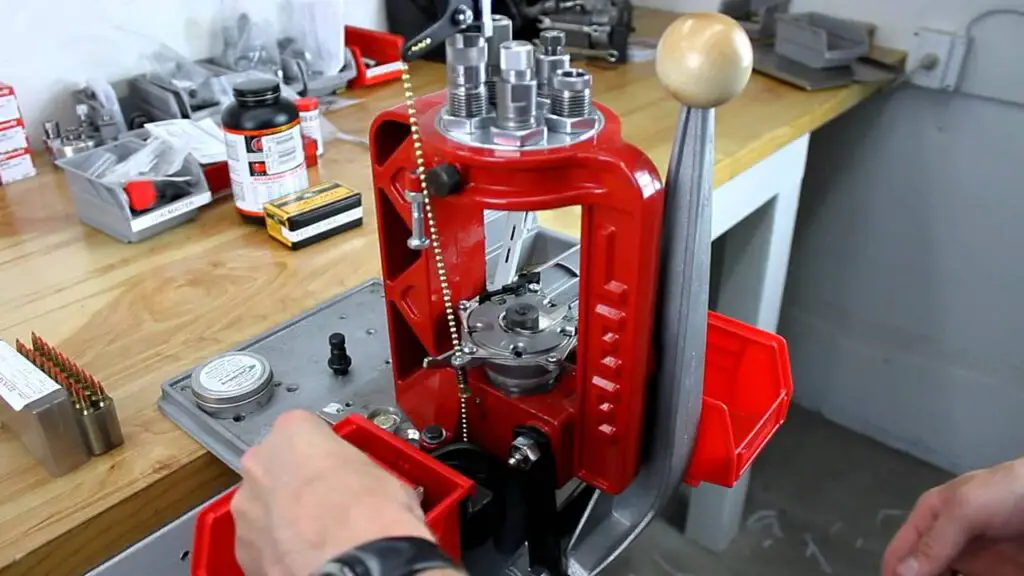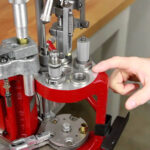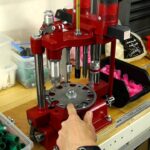With ammunition prices and availability the way they are these days, it makes sense to start reloading your own ammunition. The brass cartridge case is the most expensive ammunition component to produce, so with a steady supply of brass, you can begin reloading with a quality press. This review will look at the Lee Precision Load Master in 223 Remington.
Lee Precision is one of the oldest names in ammunition reloading, and the Lee Precision Load Master 223 Remington Reloading Rifle Kit represents a lot of value for the money.
[su_box title=” ” box_color=”#ee6409″]
Operation of the Load Master 223 Remington Kit
Initially known for their pocket sized “Lee Loader” kits, the Lee Load Master represents the extreme value when selecting an entry level or intermediate reloading press.
This five station progressive press (or turret press) comes from the factory ready to go with a set of 223 Remington dies. Still, the Lee Load Master can load any caliber up to, but not including, 50 BMG by replacing the dies, shell plate, and possibly the primer feed system if you change between small and large primers.
Once it is set up correctly, the Lee Load Master will allow you to load approximately 500 rounds per hour. This speed is accomplished due to the case feed system and automatic primer feed as long as you keep your primer tubes full and top off your powder measure.
The Lee Load Master is relatively easy to calibrate with as little as 10 or 12 rounds. These initial rounds are not intended for firing; they are expendable casualties on the road to making quality ammunition. When used with a cartridge headspace gauge or a drop gauge, you can determine whether your bullet is seated too deep or extended too far and how tight your crimp is.
One thing to be mindful of when reloading for 223 Remington with a Lee Load Master or any progressive press is the presence of military primers using surplus ammunition. These primers are crimped in place and require that the crimp be removed so a new primer can be seated.
There is no station on the Lee Load Master for this operation, so any such brass should be set aside and processed before running it through the LoadMaster. Running crimped primers through a Lee Load Master can break the de-capping pin in the first stage and, if unchecked, can damage the priming system by trying to seat a live primer on top of the one in place.
[/su_box]
[su_table]
| Pros | Cons |
| The kit is convenient because it has all the components you need to get started — the dies, shell plate, case activated powder measure, automatic case feeder, etc. The relatively low cost of the Lee Load Master makes it easy for someone who reloads for different calibers regularly to set up additional presses and have each one dedicated to a single caliber without having to change dies or recalibrate a single press every time they want to change calibers. It’s also an easy setup process, simple to switch from 5.56 to .300 with the five hole turret, and produces bullets in the blink of an eye—the casing loader words for a wide range of case sizes. | Some of the Lee Load Master parts are made from plastic and can be prone to breakage. In this review of the Lee Load Master, I recommend it for people new to reloading because assembly and setup can be challenging, but that is the world of reloading. Everything is a challenge in the beginning, and setting up a press like a Load Master will ensure that the first time hand loader will know what each stage of the press is accomplishing and why each step is important. You may also want to hand tighten the components to ensure they are snug. The instructions included with the Lee Load Master are not the best in the world, but watching some of Lee’s instructional videos is recommended to understand better how to set up and use the press. Many have been able to put the press together just fine because it comes with pictures. |
[/su_table]
[su_note note_color=”#f1d78f”]
Conclusion for the Lee Loader 223
I have had a fondness for many of Lee’s products. My first introduction to hand loading was a Lee Hand Loader for 12 Gauge Shotgun that I picked up at a yard sale for $5 in the late 1980s. As a commercial loader, I would not have one in my shop due to the sheer volume of rounds produced, and I used more expensive presses made by Camdex, Ammo Load, Dillon, and RCBS. The little red press would not survive thousands of rounds a day, every day for years on end, but that is not a purpose for which the Lee load Master is intended.
Due to their low cost, my home reloading bench features a pair of Lee Load Masters. They make it convenient to quickly and safely load half a case of quality ammunition in under 2 hours. With a few modifications and upgraded parts, they are as durable as their competition in a non-commercial environment.
At 1/2 to 1/3 the price of its competition, the Lee Load Master makes a lot of sense for beginners and advanced hand loaders.
[/su_note]



